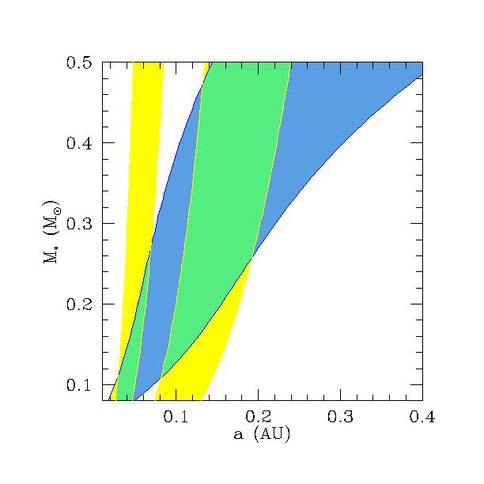2009 Annual Science Report
 VPL at University of Washington
Reporting | JUL 2008 – AUG 2009
VPL at University of Washington
Reporting | JUL 2008 – AUG 2009
Stellar Effects on Planetary Habitability
Project Summary
Habitable environments are most likely to exist in close proximity to a star, and hence a detailed and comprehensive understanding of the effect of the star on planetary habitability is crucial in the pursuit of an inhabited world. We model how stars with different masses, temperatures and flare activity affect the habitability of planets. We also address the effect that tides between a star and a planet have on planetary habitability, including the power to turn potentially habitable planets like Earth into extremely volcanically active bodies like Io.
Project Progress
We studied the impact of a large flare from the M dwarf, AD Leonis (AD Leo), on the atmospheric chemistry of a hypothetical, Earth-like planet located within its habitable zone. The AD Leo flare of 1985 April 12 emitted a total energy of ~10^34 ergs. The simulations were performed using a 1-D photochemical model coupled to a 1-D radiative/convective model. Our results indicate that the ultraviolet radiation emitted during the flare does not produce a significant change in the ozone column depth or the UV flux reaching the surface of the planet, and so such flares may not present a direct hazard for life on the surface of an orbiting habitable planet. Given that AD Leo is one of the most magnetically active M dwarfs known, this conclusion should apply to planets around other M dwarfs with lower chromospheric activity (Walkowicz et al., 2009; Segura et al., 2009)
We have explored how tidal effects can alter the surface properties of planets. We considered the specific case of HD 40307 and showed which regions of observationally-permitted parameter space led to tidal heating rates larger than on Io on HD 40307 b. We also considered the range of tidal heating that is possible in the habitable zones of low-mass stars. We proposed that one may make a second cut on planetary habitability based in the level of tidal heating: The heat flux must be less than that on Io, and more than the minimum for plate tectonics (Barnes et al., 2009)
The blue region is the “classic” habitable zone derived from estimates of stellar flux and assuming an Earth-like atmosphere (see Selsis et al. 2007). Yellow regions represent regions in which tidal heating of a 10 Earth mass terrestrial planet is favorable for habitability, the left strip assumes an orbital eccentricity of 0.01, the right 0.5. Green represents the overlap of the two types of habitability.
We also explored the statistical probability of detrimental effects on habitability due to astrospheric collapse for stars of different mass (Smith & Scalo, 2009) An “astrosphere” is the plasma cocoon carved out of the interstellar medium by a stellar wind. In dense interstellar clouds, the resulting pressure can collapse the astrosphere, resulting in exposure of the habitable zone to enhanced amounts of cosmic ray flux, dust and gas. We find that ISM encounters resulting in astrosphere collapse are unlikely to occur for K and M stars, but could be as frequent at 1-10 every billion years for solar mass stars or larger.
Publications
-
Barnes, R., Jackson, B., Greenberg, R., & Raymond, S. N. (2009). TIDAL LIMITS TO PLANETARY HABITABILITY. The Astrophysical Journal, 700(1), L30–L33. doi:10.1088/0004-637x/700/1/l30
-
Segura, A., Walkowicz, L. M., Meadows, V., Kasting, J., & Hawley, S. (2010). The Effect of a Strong Stellar Flare on the Atmospheric Chemistry of an Earth-like Planet Orbiting an M Dwarf. Astrobiology, 10(7), 751–771. doi:10.1089/ast.2009.0376
-
Smith, D. S., & Scalo, J. M. (2009). Habitable Zones Exposed: Astrosphere Collapse Frequency as a Function of Stellar Mass. Astrobiology, 9(7), 673–681. doi:10.1089/ast.2009.0337
- Walkowicz, L.M., Segura, A., Meadows, V., Kasting, J. & Hawley, S. (2009). The Time-Dependent Effect of a Stellar Flare on Terrestrial Planet Habitability and Biosignatures. Bulletin of the American Astronomical Society, 41: 259.
-
PROJECT INVESTIGATORS:
-
PROJECT MEMBERS:
Victoria Meadows
Project Investigator
John Armstrong
Co-Investigator
James Kasting
Co-Investigator
Thomas Quinn
Co-Investigator
John Scalo
Co-Investigator
Antigona Segura-Peralta
Co-Investigator
Rory Barnes
Postdoc
Mark Claire
Postdoc
Ravi Kopparapu
Postdoc
Sean Raymond
Postdoc
Lucianne Walkowicz
Postdoc
Kristina Mullins
Undergraduate Student
-
RELATED OBJECTIVES:
Objective 1.1
Formation and evolution of habitable planets.
Objective 1.2
Indirect and direct astronomical observations of extrasolar habitable planets.
Objective 2.1
Mars exploration.
Objective 2.2
Outer Solar System exploration
Objective 4.1
Earth's early biosphere.
Objective 4.3
Effects of extraterrestrial events upon the biosphere
Objective 5.3
Biochemical adaptation to extreme environments
Objective 6.1
Effects of environmental changes on microbial ecosystems
Objective 7.2
Biosignatures to be sought in nearby planetary systems
